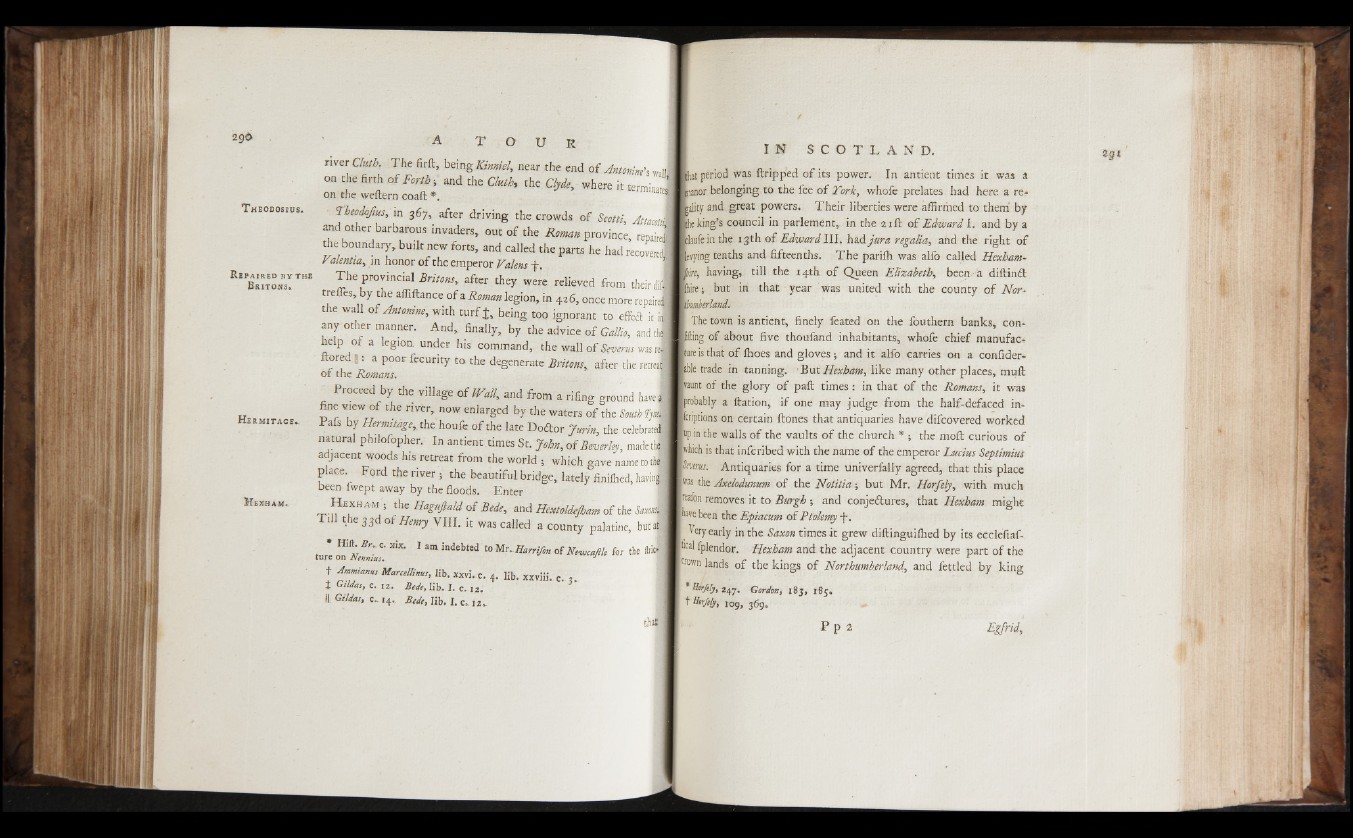
river Cluth. The firft, being Kimiel, near the end of Antonim’s wall
on the firth of Forth; and the Cluth the Clyde, where it terminaj
on the weftern coaft *. 1
• Theodofius, in 367, after driving the crowds of Scotti, AttmM
and other barbarous invaders, out of the Roman province repair!
the boundary, built new forts, and called the parts he had recover J
Valentia, in honor of the emperor Valens f
RE= ; sI TH£ The provincial after they were relieved from theirdJ
trefies, by the affiftance o ilm a n legion, in 426, once more repair el
the wall of Antonine, with tu r fj, being too ignorant to effeft it ¡1
any other manner. And, finally, by the advice of Gallic, and ti!
help of a legion under his command, the wall of Sevens was k1
ftored I): a poor fecurity to the degenerate Britons, after the retreat ^
or the Romans.
Proceed by the village of Wall, and from a. rifing ground have i i
fine view of the river, now enlarged by the waters of the South 3) J
r m i t a c e , Pafs b.y Hermitage,, the houfe of the late Doftor Jurin, the Celebrate!
natural philofopher. In antient times St .John, of Beverley, madet I
adjacent woods his retreat from the world ; which gave name to t J
place.^ Ford the river ; the beautiful bridge, lately finilhed, havinJ
been fwept away by the floods. Enter
H exham. H e x h am ; the Haguftald of Bede, and Hextoldejham of the Saxo J
Till the 33d of Henry VIII. it was called a county palatine, butal
t u r l *'*' 1 a ” k d e b t e d ‘ ° M r * H a r r i fm o f the
t Ammtanui Marcellinus, lib . x xvi. c. 4. lib . x x v iii. c . s
i GiUas, c. 12. Bede, lib . I . c - 1 z . '
II. Gildat, c., 1 4 , Bede, lib . I. c . 12 -
tBa
U period was ftripped of its power. In antient times it was a
jianor belonging to the fee of Tork, whofe prelates had here a re*
kality and great powers. Their liberties were affirmed to them by
[lie king’s council in parlement,. in the 2 ill of Edward I. and by a
plaufe in the 13 th of Edwardlll. hud jura regalia, and the right of
levying tenths and fifteenths. The pariih was alfo called Hexham-
Krt, having, till the 14th of Queen Elizabeth, been a diftinA
lire; but in that year was united with the county of Nor-
mmbtrland.
The town is antient, finely feated on the fouthern banks, con-
piling of about five thoufand inhabitants, whofe chief manufacture
is that of fhoes and gloves; and it alfo carries on a confider-
able trade in tanning. • But Hexham, like many other places, mull:
hunt of the glory of paft times: in that of the Romans, it was
probably a ftation, if one may judge from the half-defaced inscriptions
on certain ftones that antiquaries have difcovered worked
pp in the walls of the vaults of the church * ; the moil curious of
Vhich is that infcribed with the name of the emperor Lucius Septimius
him. Antiquaries for a time univerfally agreed, that this place
* the Axelodumm of the Notitia-, but Mr. Horfely, with much
Non removes it to Burgh -, and conjectures, that Hexham might
fcwe been the Epiacum of Ptolemy -f.
Very early in the Saxon times it grew diftinguilhed by its ecclefiaf-
tal fplendor. Hexham and the adjacent country were part of the
crown lands of the kings of Northumberland,, and fettled by king
' Htrfily, 247. Gordon, 183, r 8 j .
t Sor/eljf, IOJ,
Egfrid,